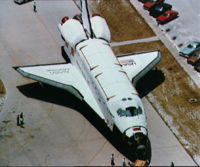Space Shuttle Challenger
2007 Schools Wikipedia Selection. Related subjects: Space transport
 |
|
|
|
|
|---|---|
| Orbiter Vehicle Designation: | OV-099 |
| Country: | United States |
| Contract award: | 26 July 1972 |
| Named after: | HMS Challenger |
| First flight: | STS-6 4 April 1983 – 9 April 1983 |
| Last flight: | STS-51-L 28 January 1986 |
| Number of missions: | 10 |
| Crews: | 60 |
| Time spent in space: | 62.41 days |
| Number of orbits: | 995 |
| Distance Travelled: | 41,527,416 km |
| Satellites deployed: | 10 |
| Status: | destroyed 28 January 1986 |
Space Shuttle Challenger ( NASA Orbiter Vehicle Designation: OV-099) was NASA's second Space Shuttle orbiter to be put into service, after Columbia. Its maiden voyage was on April 4, 1983, and it made eight further round trips to low earth orbit before breaking up 73 seconds after the launch of its tenth mission, on January 28, 1986, killing all 7 crew members. (For more on the Challenger disaster, see Space Shuttle Challenger disaster.) It would be replaced by the space shuttle Endeavour, launched six years after the 51-L disaster.
Challenger was constructed using a body frame (STA-099) that had initially been built as a test article. STA-099 had not been meant for spaceflight, but NASA discovered that recycling it would be less expensive than refitting the test shuttle Enterprise (OV-101) to be spaceworthy, as originally planned. The spacecraft was named after a British corvette which carried out a pioneering global marine research expedition in the 1870s . Unlike Columbia, Challenger was the first Orbiter to be delivered with fewer tiles on its Thermal Protection System. Most of the tiles were replaced with DuPont white nomex felt insulation on the payload bay doors, upper wing surface and rear fuselage surface, allowing Challenger to carry 2,500 lbs. more than Columbia. It was also the first Orbiter to have a heads-up display system similar to those found in military and newer civilian aircraft to allow the commander and pilot to see important data during reentry and landing, eliminating the need to look at the instrument panel during descent and allowing them to concentrate on flying the Orbiter.
Challenger, along with Discovery was modified at KSC to be able to carry the Centaur-G upper-stage in its payload bay. Had STS-51-L been successful, Challenger's next mission would have been the deployment of the Ulysses probe with the Centaur to study the polar regions of the Sun.
Challenger was one of two space shuttles destroyed in an accident during a mission, the other being Columbia. The collected debris of the vessel is currently stored in decommissioned missile silos at Cape Canaveral Air Force Station. From time to time, further pieces of debris from the orbiter wash up on the Florida coast. When this happens, they are collected and transported to the silos for storage.
Flights
Space Shuttle Challenger flew 10 flights, spent 62.41 days in space, completed 995 orbits, and flew 25,803,940 statute miles in total, including its final mission.
| Date | Designation | Notes |
|---|---|---|
| 1983 April 4 | STS-6 | Deployed TDRS-1. First spacewalk during a space shuttle mission. |
| 1983 June 18 | STS-7 | Sally Ride becomes first American woman in space. Deployed two communications satellites. |
| 1983 August 30 | STS-8 | Guion Bluford becomes first African-American in space First shuttle night launch and night landing. |
| 1984 February 3 | STS-41-B | First untethered spacewalk. Deployed two communications satellites, unsuccessfully. |
| 1984 April 6 | STS-41-C | Solar Maximum Mission service mission. |
| 1984 October 5 | STS-41-G | First mission to carry two women. Marc Garneau become first Canadian in space. |
| 1985 April 29 | STS-51-B | Carried Spacelab-3 |
| 1985 July 29 | STS-51-F | Carried Spacelab-2 |
| 1985 October 30 | STS-61-A | Carried German Spacelab D-1 |
| 1986 January 28 | STS-51-L | Shuttle disintegrates after launch, killing all seven astronauts on board. |
Loss of Challenger
Challenger was destroyed in the second minute of STS-51-L, the orbiter's tenth mission, on January 28, 1986, when an O-ring seal on its right solid rocket booster failed. This allowed a plume of flame to stream out of the SRB that weakened Challenger's external fuel tank, leading to the orbiter's rapid breakup under aerodynamic stresses. A subsequent investigation concluded that poor design of the SRB seals, unusually cold temperatures that weakened the O-rings, and lack of inspection were to blame for the disaster.

